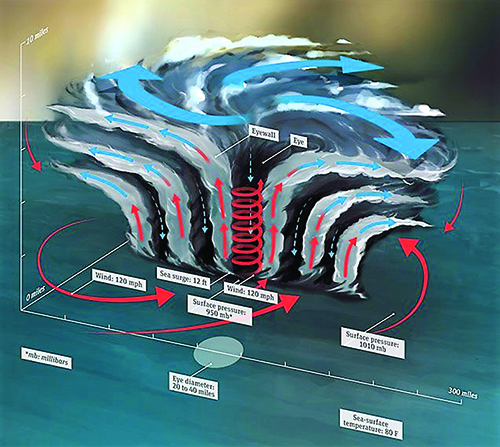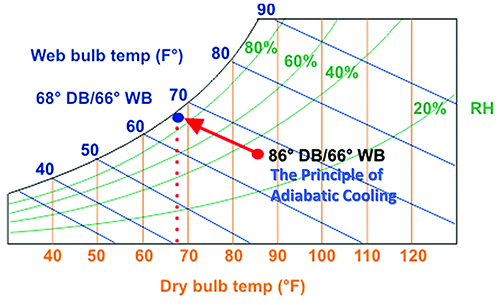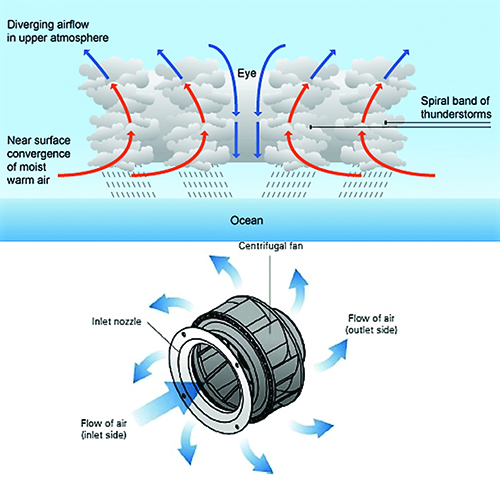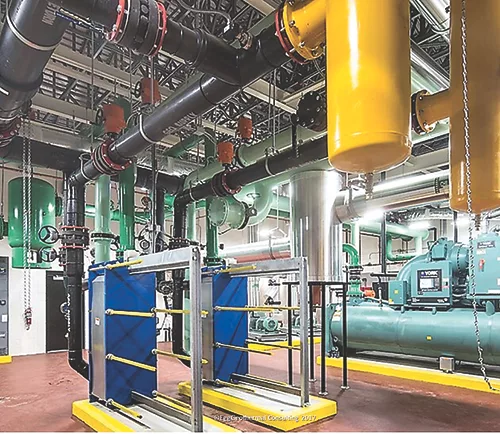
Centrifugal fans are commonly used to produce air movement in HVAC systems. The addition of water to the process can provide a cooling effect in certain situations. This type of cooling is called “adiabatic cooling,” or more commonly referred to as “evaporative cooling.” The principle behind it is basically that without actually removing any energy, the addition of water will cause the dry-bulb temperature to decrease as the water evaporates. This happens because as the water evaporates, the same energy content occupies a larger volume, so the dry-bulb temperature goes down.
During my talks most recently in September and October in New York State, I’ve had several opportunities to share some of my personal, non-scientific insights into this interesting phenomenon. The Earth, which is a living breathing organism, actually has its own defenses against getting too warm. It fans itself off with hurricanes, and in the process, the oceans cool down.
Using a psychrometric chart, it’s easy to see the “adiabatic line” that illustrates how cooling effect comes from addition of water as it evaporates into the moving air. Cooling towers use this concept to achieve greater effectiveness than dry cooling alone. In dry desert-like climates, many folks can achieve air conditioning-like comfort without mechanical refrigeration. Just look at the psychrometric chart and you can see that a 30 F drop in temperature is achievable if the RH is 20 percent to 30 percent to begin with.

Hurricanes look, and work, like a centrifugal fan, and seem to be using the heat from our warm oceans to drive this “cooling fan.” In the hurricane cross-section, look at the warm, moist air being sucked up and flung out in a centrifugal fashion, while the cooler air from the upper atmosphere is pulled down through the very center. It appears to me that global warming corrects itself quite effectively through these natural centrifugal fans. Thermal images of the Atlantic Ocean before and after a hurricane confirm hurricanes effectively drop the ocean temperatures by several degrees in their wake.
The problem with this seemingly innocent cooling process is that millions of people’s lives are affected during it. If we increase our building codes to withstand 200 MPH, and raise the flood-plain another couple dozen feet, we should be able to adapt. That’s a lot of painful work (to say the least).
Maybe it would be better if we did our part to slow the warming of the ocean by reduction of greenhouse-gas (GHG) emissions, thus reducing storms and other GHG related concerns.
The fact is that about 1/3 of GHG emissions come from combustion heating of buildings. We can’t achieve the reductions needed nationwide and worldwide unless we eliminate combustion heating. Heat pumps are the key, and geothermal heat pumps (GHPs) are the best solution.
On the other side of this argument is the issue of making buildings storm- and flood-proof. The first step for the HVAC system is to eliminate the outdoor equipment, and the second is to elevate it to a reasonable height above the flood plain. The best path toward eliminating outdoor equipment such as cooling towers, fuel tanks, fluid coolers, and air-cooled condensers is to switch to an earth coupled source — geothermal HVAC. Geothermal HVAC systems have reasonable solutions to all of the challenges I’ve shared thus far.
A building is basically useless without electricity and a operational HVAC system. The chances of keeping the HVAC up and running after a storm go up considerably when the equipment is protected and housed inside a mechanical room. With outside equipment eliminated, several other health, human safety and conservation measures are satisfied.
The building no longer has: Legionella threats from cooling towers; noise pollution from outside equipment; high water consumption from cooling towers; wasted outside space (normally adjacent to, or on top of the building); service-related roof issues (from maintenance personnel accessing and working on the roof); chemicals maintenance and consumption related to cooling tower water treatment; combustion heating, fossil-fuel consumption and associated GHG emissions; periodic replacement costs for cooling towers and outside condensors (normally a 15-year cycle).
Architects, professionals and building owners, once they are educated on these benefits, choose geothermal HVAC because of the reduction of liability, and increased comfort and longevity for their facilities. Geothermal HVAC systems liberate owners and design professionals from all of these concerns.
The facts are irrefutable; as much as 35 to 40 percent of GHG emissions come from combustion heating. New York has taken this information to the street in the form of Renewable Heating and Cooling Training Sessions for Professionals and Students. In addition, it is supporting numerous groups in the efforts of consumer outreach. Some of these include New Yorkers for Clean Power, Renewable Heat Now, and others that can be seen on the NY-GEO website.
Geothermal HVAC is the best solution for any building seeking to increase its resiliency, energy efficiency and reduce GHG emissions. For more information, please visit IGHSPA , GEO (www.geoexchange.org), NY-GEO and NYSERDA.
References: Hurricanes and Climate Change; Kerry Emanuel, MIT http://slideplayer.com/slide/4370720/
http://slideplayer.com/slide/6173505/ l






